|
|
ARTHROPODS:
Insects»
Spiders»
Centipedes»
Millipedes»
Sowbugs»
Harvestmen»
Mites
& Ticks»
Scorpions»
Identification
Tips»
About
the Critter Files»
Links» |
|
|
|
| Although most common
soldier beetles found in Kentucky are orange with black markings,
a few are black with orange markings and closely resemble lightningbugs
(shown below). In fact, lightning beetles and soldier beetles
are closely related. Both are elongated in shape, have relatively
soft elytra, and both are often patterned with black and orange.
|
| |
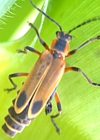 Typical
Soldier Beetle
Typical
Soldier Beetle
(B. Newton, 2003) |
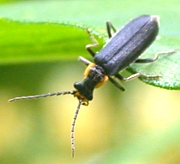 Soldier
Beetle with "Lightningbug" color pattern
Soldier
Beetle with "Lightningbug" color pattern
(B. Newton, 2003)
|
| |
| However, the
heads of soldier beetles are never concealed by the "pronotum"
(first dorsal segment of the thorax) as with Lightningbugs (shown
below). |
| |
 Lightningbug:
head concealed by pronotum
Lightningbug:
head concealed by pronotum
(B. Newton, 2003) |
 Soldier
Beetle: head not concealed
Soldier
Beetle: head not concealed
(B. Newton, 2003) |
| |
| Most soldier
beetle larvae (shown below in the Life Cycle
section) are found low to the ground and under rock and logs. They
are soft-bodied with 6 legs and chewing mouthparts. |
|
| SIZE:
Adult and larval body length up to 3/4" |
| |
| LIFE
CYCLE |
|
Like
all beetles, soldier beetles have "complete" metamorphosis
with egg, larval, pupal, and adult stages. Female soldier
beetles place eggs in moist soil or in leaf litter in lawns, meadows,
and forests. Upon hatching in the summer, larvae live and
feed at the soil level. Most species pupate in the fall in
small chambers in the soil and adults emerge in late spring, then
mate and deposit eggs during the summer. |
| |
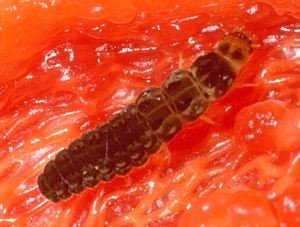 Soldier
Beetle larva (R. Bessin, 2000)
Soldier
Beetle larva (R. Bessin, 2000) |
| |
| ECOLOGY |
|
| |
The larvae
of many soldier
beetle species are predators that feed on small insects, worms,
slugs, and snails. They hunt in leaf litter and in other locations
that are damp and close to the soil. A few species hunt under
loose bark. The larvae of other soldier beetles are herbivores
that feed on potato, celery, and other garden plants. As adults,
some soldier beetle species feed on nectar and pollen, while others
are predators that hunt for aphids and other soft-bodied insects.
Soldier beetles
and their larvae are a food source for other animals. Birds,
bats, and spiders feed on the adults. Spiders, ground beetles,
and other soil-dwelling predators feed on the larvae.
|
| |
| PEST
STATUS |
|
Soldier
beetles are not considered pests. Predatory species sometimes
reduce pest populations (especially aphids) and are considered beneficial.
|
| |
| COMMON
KENTUCKY SOLDIER BEETLES |
|
|
LEATHERWINGS
GENUS: Chauliognathus
In Kentucky, the most
commonly seen soldier beetles are probably the Leatherwings.
These beetles belong to the Chauliognathus genus
and are typically 1/2-3/4" long and orange with black markings.
The Goldenrod Leatherwing, Chauliognathus
pennsylvanicus, (below left) is commonly seen in late summer
and early fall on goldenrod flowers where it feeds on nectar, pollen,
and insects. It is also called the "Pennsylvania Leatherwing."
Below right is the Margined Leatherwing,
Chauliognathus marginatus. It is also common on flowers
in summer in Kentucky. |
| |
 Goldenrod
Leatherwing, Chauliognathus pennsylvanicus
Goldenrod
Leatherwing, Chauliognathus pennsylvanicus
(R. Bessin, 2000) |
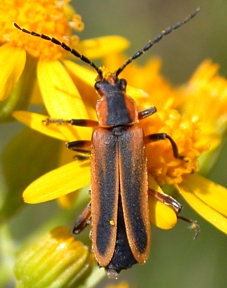 Margined
Leatherwing, Chauliognathus marginatus
Margined
Leatherwing, Chauliognathus marginatus
(B. Newton, 2004) |
|
|
|
Podabrus
spp.
GENUS: Podabrus
Soldier beetles in the
genus Podabrus are also very common in
Kentucky. These soldier beetles are black with orange markings
and closely resemble lightningbugs. The species pictured below
is common during early summer in meadows, fencerows, gardens, and
other areas with thick, sunlit vegetation. These soldier beetles
are smaller (less than 1/2") than most other common solider
beetles. They also seem to be more active and take flight
more quickly than leatherwings and other soldier beetles. |
| |
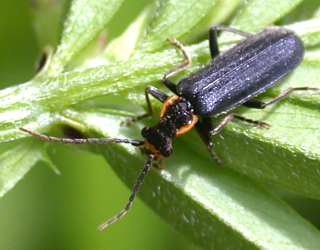 Soldier
Beetle, Podabrus sp. (B. Newton, 2004)
Soldier
Beetle, Podabrus sp. (B. Newton, 2004) |
|
| |
| COLLECTING
& PHOTOGRAPHY |
|
Adult soldier beetles
are easy to find during the summer in Kentucky. Look for them
on flowers and weedy plants in lawns, meadows, and on the edges
of woodlands. Because they are slow-moving and tend to spend
their time in sunny areas, it is usually easy to snap pictures of
adult soldier beetles. Most soldier beetles are relatively
slow-moving and easy to capture. Soldier beetle larvae are
common in Kentucky but can be difficult to find because they hunt
in concealed areas like thatch and leaf-litter. Sometimes
they can be seen crossing roads and sidewalks at night and after
summer rains. If collected, soldier beetle larvae (like all
insect larvae) should be preserved in alcohol.
|
| |
| MYTHS
- LEGENDS - FOLKLORE |
|
"Leatherwings"
are so-named because of their soft-but-tough outer wings.
Do you know any other
myths, legends, or folklore about soldier beetles? If so,
let us know! |
| |
Original document: 5 July 2006
Last updated: 5 July 2006
Photos courtesy R. Bessin and B. Newton, University of Kentucky
The Kentucky Critter
Files are maintained by Blake Newton, Department of Entomology, University
of Kentucky.
Contact: blaken@uky.edu
|
|

